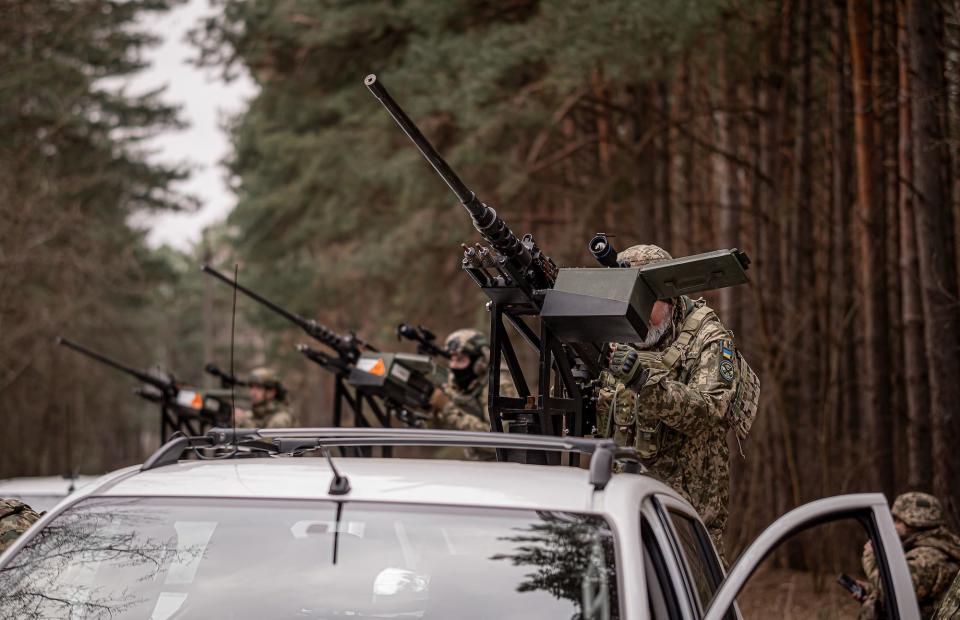-
Israel is considering mounting rotary cannons on armored vehicles to shoot down drones.
-
Israel may place the Vulcan gun used on F-16s on an armored personnel carrier.
-
Ukraine uses autocannons and heavy machine guns to target incoming drones.
Ukraine and Israel are exploring cost-effective ways to counter drones as they both face repeated attacks from their determined adversaries.
Israel does explore the feasibility of mounting the six-barrel M61 Vulcan guns found on US fighter jets atop armored vehicles deployed in the country’s northern border areas with Lebanon. The Iranian-backed Hezbollah has done just that tripled the number of drone attacks on northern Israel in the past three months, forcing Israel to seek an effective counterbalance without resorting to missiles.
Israel has one of the most advanced in the world anti-aircraft defense networks, but still has problems countering these drones. The M61 may prove a viable, cost-effective solution for the point defense of armored columns and ground forces.
Ukraine is at the forefront of drone defense. Its forces have come up with a new solution to counter Russia’s Iranian-supplied Shahed drones. Kiev uses an extensive network of sensors to detect Russia’s low-flying drones relay target data to heavy machine guns And anti-aircraft guns mounted on vehicles across the country which they then attempt to take down.
There are similarities between Ukraine’s strategy and Israel’s new approach, says Federico Borsari, defense expert at the Center for European Policy Analysis (CEPA).
“In principle, this effort is similar to what Ukraine has done with the creation of mobile anti-drone teams with heavy machine guns, powerful searchlights and other sensors to counter Shaheds and other slow-flying drones at low altitudes,” Borsari told Business. Insider.
“This type of capability – which is relatively simple in nature – will be relevant to the counter-unmanned aerial system (C-UAS) task in the future, but is not the only one, and will be integrated into a broader range of other capabilities . capabilities,” Borsari said.

Ukraine needs a cost-effective solution to defeat the thousands of Russian one-way drone attacks that have forced Kiev to use large quantities of its expensive air defense missiles to shoot down. German-supplied Gepards, a gun design dating back to the 1960s, have proven highly effective at countering the Russian drones and are a cheaper solution than more modern air defenses such as the NASAMS; each NASAMS rocket costs about $1 million. However, Ukraine faces serious difficulties acquiring more ammunition for Gepard’s automatic cannons.
“I think the Israelis probably see what works and what doesn’t in Ukraine – the key is creating an effective and relatively cheap defense against incoming drones, and the Ukrainians are currently one of the leading developers in that area,” says Samuel Bendett . an expert in unmanned and robotic military systems at the Center for Naval Analyses, told Business Insider.
“Another aspect to consider is that such weapons may work against specific types of drones, but not others,” Bendett said.
CEPA’s Borsari believes the M61 cannon could be an “interesting solution” to counter certain drones.
“In principle, its use in both fixed and mobile applications is not new and conceptually similar to many other anti-aircraft guns that have been used in Ukraine for counter-drone purposes,” Borsari said.
“The integration with radar or electro-optical/infrared (EO/IR) tracking sensors can certainly improve its accuracy, but this weapon is still intended for short-range C-UAS missions,” Borsari added. “For example, the radar-guided Phalanx close-in weapon system has been used by the U.S. and other navies for decades.”
The M61 is carried by fighter jets such as the F-16 Fighting Falcon and the F/A-18 Hornet that can fire the 20mm rounds at targets up to almost three kilometers away. It has the power and rate of fire to destroy incoming drones, but its cost-effectiveness depends on how many bullets it has to shoot to do so.
“The longer the burst, the higher the cost per interception due to the use of more bullets,” Borsari said, noting that it costs $180,000 to fire the M61 for one minute, during which time it can fire 6,000 rounds .
“Additionally, it may be difficult to deploy faster drones,” Borsari said. “There are now short-range missiles and guided missiles intended for C-UAS costing about $40,000 each, along with reusable missiles equipped with a powerful microwave payload (Coyote Block-3) to defeat swarms at short range. “
“So overall, the M61 may be a solution, but it is not the only one.”
Israel before integrated M168 Vulcan guns and FIM-92 Stinger missiles on its Machbet short-range air defense system, which it developed in the 1990s based on the American armored personnel carrier M113 to defend infantry against air attacks. The current evaluation of the M61 could be the first step towards developing something similar to tackle low-flying drones.
Interestingly enough, that was an unmanned Israeli M113 reportedly seen in southern Gaza in recent days.
Borsari believes the M113 is a type of vehicle that could be “repurposed” as an unmanned ground vehicle (UGV) to defeat drones.
“Soon, UGVs will certainly be used in the C-UAS configuration and gradually integrated into maneuver formations, although they will not necessarily be the standard mobile air defense capability,” Borsari said.
“Instead, they will be part of a diverse and layered set of capabilities for C-UAS, attached to ground formations, some manned, some unmanned, and equipped with various effectors – both kinetic and non-kinetic – including heavy automatic cannons, short-range stand-off missiles, directed energy such as powerful microwaves and electronic warfare.”
Read the original article on Business Insider







